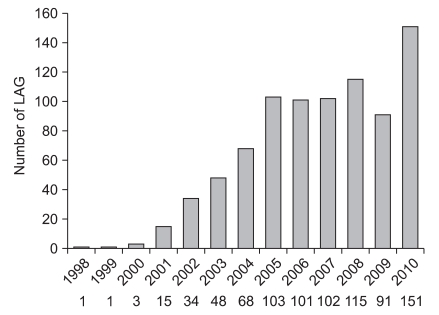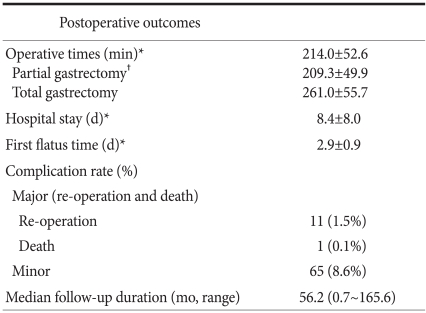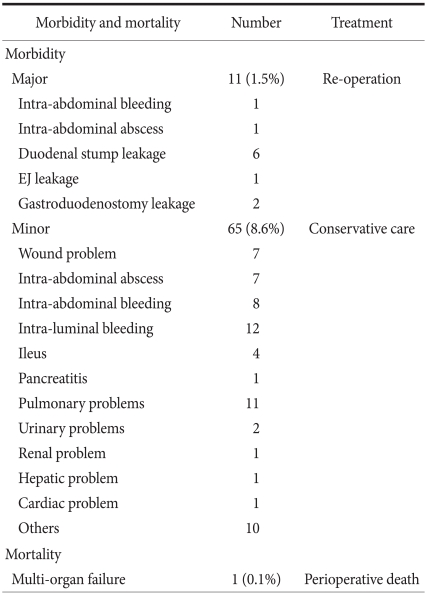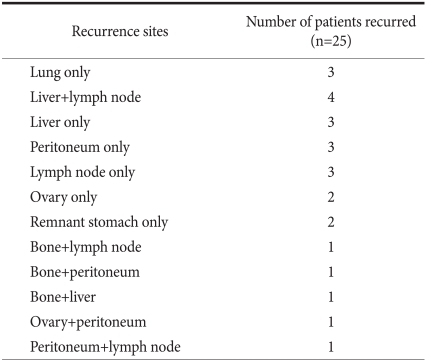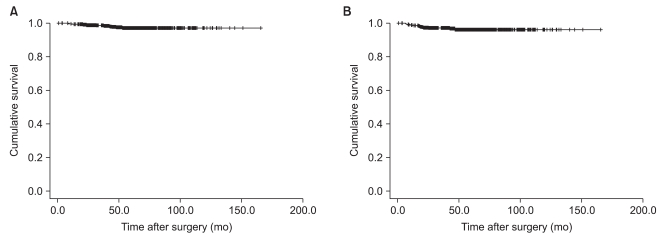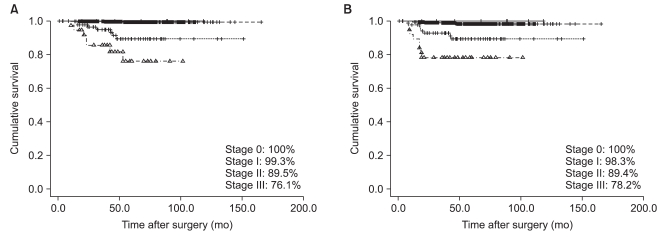Abstract
Purpose
Recently, laparoscopy-assisted gastrectomy (LAG) has been widely accepted modality for early gastric cancer in Korea. The indication of LAG may be extended in an experienced institution. In our institution, the first case of laparoscopy-assisted gastrectomy (LAG) for gastric cancer was performed in May 1998. We retrospectively reviewed the long-term oncologic outcomes over 12 years to clarify the feasibility of LAG for gastric cancer.
Materials and Methods
The authors retrospectively analyzed 753 patients who underwent LAG for gastric cancer, from May 1998 to August 2010. We reviewed clinicopathological features, postoperative outcomes, mortality and morbidity, recurrence, and survival of LAG for gastric cancer.
Results
During the time period, 3,039 operations for gastric cancer were performed. Among them, 753 cases were done by LAG (24.8%). There were 69 cases of total gastrectomy, 682 subtotal gastrectomies, and 2 proximal gastrectomies. According to TNM stage, 8 patients were in stage 0, 619 in stage I, 88 in stage II, and 38 in stage III. The operation-related complications occurred in 77 cases (10.2%). Median follow-up period was 56.2 months (range 0.7~165.6 months). Twenty-five patients (3.3%) developed recurrence, during the follow-up period. The overall 5-year and disease free survival rates were 97.1% and 96.3%, respectively.
Conclusions
The number of postoperative complications and survival rates of our series were comparable to the results from that of other reports. The authors consider LAG to be a feasible alternative for the treatment of early gastric cancer. However, rationale for laparoscopic surgery in advanced gastric cancer has yet to be determined.
Keywords: Laparoscopy, Gastric cancer, Survival
Introduction
Surgical resection for gastric cancer is the only therapeutic modality for curability.(1) Laparoscopy-assisted gastrectomy (LAG) has been applied and increased significantly in the surgical management of gastric cancer in recent years. In Asian countries, such as Japan and Korea, it has become a standard therapy for early stage gastric cancer.(2,3) Several studies have demonstrated short-term postoperative advantages of LAG.(3-5) Kitano et al.(2) reported excellent long-term outcome of laparoscopic gastrectomy in a retrospective multicenter study for early gastric cancer. Recently, there was first multicenter, prospective, randomized trial for laparoscopy-assisted distal gastrectomy to assess the short- and long-term outcomes for early gastric cancer in Korea (Korea Laparoscopic Gastrointestinal Surgery Study Group [KLASS] trial).(6) In the near future, this trial will prove that laparoscopic surgery is feasible and acceptable procedure and will hopefully answer the concern of long term outcomes. Furthermore, improvements in instruments and laparoscopic technique have allowed for widespread acceptance of laparoscopic surgery, not only for distal gastrectomy but also for other gastrectomy.(7-9) As a results, study is needed to confirm that this procedure is oncologically feasible from a long-term follow-up perspective.
Since 1998, 753 cases of LAG have been performed at our institution by two surgeons. Based on these data of our 12 year experience, we have reviewed the oncological outcomes for laparoscopy-assisted gastrectomy, to determine its long-term effectiveness and patient survival.
Materials and Methods
Between May 1998 and August 2010, 3,039 operations for gastric cancer were performed in our institute. Among them, 753 patients underwent LAG by two experienced surgeons. We assessed the depth of invasion preoperatively by means of endoscopy and endoscopic ultrasonography and assessed the presence or absence of lymph node metastases using computed tomography. In early periods, our indication of LAG for gastric cancer was cT1N0M0 according to the 6th edition of the American Joint Committee on Cancer (AJCC) staging criteria.(10) In 2006, we extended the indication to T2N1M0. We excluded the patients who were candidates for endoscopic submucosal dissection from this study.
Data obtained for each patient included the following: age, sex, body mass index (BMI), comorbidity disease, tumor size, histological type, tumor location, type of gastrectomy, reconstruction, resection margin, T stage, extent of lymph node dissection, N stage, postoperative outcomes, recurrences, survival, and gastric cancer stage classified according to the 7th edition of the AJCC staging criteria.(11) The classification of lymph node dissection was done according to 2010 Japanese gastric cancer treatment guidelines (ver.3).(12) All the values were expressed as means±standard deviations.
All patients were managed routinely using a standardized postoperative protocol as follows: (1) no nasogastric intubation or preoperative mechanical bowel preparation, (2) minimal spillage of gastric contents, (3) the use of one or two closed suction drains, (4) sips of water at 48 hours after the operation, (5) a clear liquid diet at three days after the operation, and (6) discharge at six or seven days after a soft diet with no abnormal clinical symptoms. In advanced gastric cancer cases with stages beyond stage II, they received six cycles of adjuvant chemotherapy with intravenous 5-fluorouracil and cisplatin.
Follow-up results were obtained from patient hospital records, and telephone calls, and recurrence was determined by endoscopy, computed tomography, and positron emission tomography. All the follow-up patients were monitored postoperatively by a routine check for blood tests, tumor marker (Alpha-Fetoprotein, carcinoembryonic antigen, and carbohydrate antigen 19-9), chest radiography, endoscopy, and computed tomography. In patients with early gastric cancer, follow-up studies were performed every six months for the second year and annually for the following years. For patients with advanced gastric cancer, studies were carried out every three months for the first year, every six months for next year, and annually for the next three years.
Statistical results of the clinicopathologic factors and postoperative outcomes were analyzed using GraphPadInStat® (version 3.06, GraphPad Software Inc., San Diego, CA, USA). Survival curves were calculated by the Kaplan-Meier method using SPSS version 18.0 (SPSS Inc., Chicago, IL, USA).
1. Surgical procedure
All laparoscopy-assisted gastrectomies were performed according to the standard procedure guidelines as follows. All patients were placed in lithotomy position under general anesthesia. The surgeon stood on the patient's right, with the first assistant on the patient's left and the camera assistant between the patient's legs. Routinely, an umbilical trocar (11 mm) was inserted using the open method. A carbon dioxide pneumoperitoneum was created through the umbilical port, and the pressure was maintained between 12 and 14 mmHg. A rigid (30 degree) laparoscope was then introduced through the umbilical port. Under laparoscopic guidance, four trocars were introduced, consisting of bilateral subcostal (right side 5 mm, left side 11 mm) and bilateral mid-abdominal ports (right side 12 mm, left side 5 mm). First, the greater omentum wasdivided at the mid portion of the transverse colonabout 4~5 cm from the gastroepiploic arcade toward the lower pole of the spleen using Harmonic ACE (Ethicon Endo-Surgery, Cincinnati, OH, USA). Next, the right omentum and lymph nodes were dissected along the right gastroepiploic vessels (no. 4d). The infrapyloric nodes (no. 6) and the nodes along the superior mesenteric vein (no. 14v) were dissected. After the suprapyloric nodes (no. 5) and the nodes along the proper hepatic artery (no. 12a) were dissected, the duodenum just distal to the pyloric ring was transected. Then the nodes along the common hepatic artery (no. 8a) and the proximal splenic artery (no. 11p) were dissected. After dissecting of the nodes along the left gastric artery (no. 7) and the nodes around the celiac artery (no. 9), dissection of the right cardial nodes (no. 1) and the nodes along the lesser curvature (no. 3) were performed. A 5-cm upper midline or transverse skin incision was made from the substernal angle or right subcostal area, and an incision template (Alexis™ Wound retractor, Applied Medical, Rancho Santa Margarita, CA, USA) was applied on the incision site. Billroth I gastroduodenostomy was performed by a circular stapler (Proximate CDH 29; Ethicon Endo-Surgery), and Billroth II gastrojejunostomy using flexible laparoscopic stapling devices (Echelon Flex, Ethicon Endo-Surgery) was performed or a hand-sewing technique was adopted as used for conventional open surgery. In case of total gastrectomy, the short gastric vessels were divided from the lower pole to the upper pole of the spleen, and the lymph nodes along the short gastric vessels (no. 4sa) were dissected. Additionally, the lymph nodes along the distal splenic artery (no. 11d) and the left paracardial lymph nodes (no. 2) were dissected. Reconstruction of total gastrectomy was extracorporeally performed by Roux-en-Y anastomosis. After jejunojejunostomy, esophagojejunostomy was performed using a circular stapler (Proximate CDH 25; Ethicon Endo-Surgery).
Results
1. Patient characteristics
Since May 1998, laparoscopy-assisted gastrectomies have gradually increased in our institute (Fig. 1). The clinicopathological characteristics ofthe patients are presented in Table 1. The mean age was 58.4±12.7 years (range, 24~87 years). Among those 753 patients who underwent laparoscopic surgeries, 462 were men (61.4%) and 291 were women (38.6%). The mean body mass index was 23.2±2.9 kg/m2. The mean tumor size was 2.9±2.1 cm. The most common histologic type was poorly differentiated. Most of the tumor was located at the lower area of stomach. Subtotal gastrectomy and BillrothI anastomosis were the most common procedure. Proximal and distal margins of partial gastrectomy (Partial gastrectomy includes distal subtotal gastrectomy and proximal subtotal gastrectomy) were 4.8±2.8 and 5.6±3.0 cm and those of total gastrectomy were 3.6±3.5 and 12.1±4.8 cm, respectively. According to the TNM stages (AJCC 7th edition), stage 0 was found in 8 (1.1%) patients, I in 619 (82.2%) patients, II in 88 (11.7%), III in 38 (5.0%). Seven hundred and sixteen patients received over D2 dissection according to 2010 Japanese gastric cancer treatment guidelines (ver.3).(12) The mean number of retrieved lymph nodes of partial gastrectomy was 34.1±13.9 and that of total gastrectomy was 40.6±17.1, respectively (Table 1).
Fig. 1.
Annual results of laparoscopy-assisted gastrectomy. LAG = laparoscopy-assisted gastrectomy.
Table 1.
Clinicopathological features
*All values are the mean and standard deviation. †Partial gastrectomy includes distal subtotal gastrectomy and proximal subtotal gastrectomy. LAG = laparoscopy-assisted gastrectomy.
2. Postoperative outcomes
For all 753 patients, the meanoperation time was 214.0±52.6 min (range, 110~415 min; partial gastrectomy, 209.3±49.9 min; total gastrectomy, 261.0±55.7 min). The mean postoperative hospital stay and the length of time until the first flatus were 8.4±8.0 days and 2.9±0.9 days, respectively (Table 2). There were 76 operation-related morbidities (10.1%) and one mortality (0.1%). Eleven major complications (intra-abdominal bleeding, one case; intra-abdominal abscess, one case; duodenal stump leakage, six cases; esophagojejunostomy leakage, one case; gastroduodenostomy leakage, two cases) needed re-operation. Sixty-five patients with minor complications were treated with conservative care. One patient died from multi-organ failure after 28 postoperative days (Table 3).
Table 2.
Postoperative outcomes
*All values are the mean and standard deviation. †Partial gastrectomy includes distal subtotal gastrectomy and proximal subtotal gastrectomy.
Table 3.
Postoperative morbidity and mortality
EJ = esophagojejunostomy.
3. Follow-up results
The median follow-up period was 56.2 months (range 0.7~165.6 months). Tumor recurrence was detected in 25 patients (3.3%) during the follow-up period. The sites of recurrence are shown in Table 4. Twenty-five patients had a total of 34 specific sites of recurrence. Hepatic and lymph node metastasis were the most common specific sites of recurrence. As for lymph node metastases, one patient was found at para-aortic area, 2 at extra-abdominal area, 1 at peripancreatic area, 1 at pericholedochal area, and 1 at perigastric area.
Table 4.
The sites of recurrence
The overall 5-year survival rate and disease free survival rate were 97.1% and 96.3%, respectively (Fig. 2). According to TNM stage, the overall 5-year and disease-free survival rates were 100% for 8 patients with stage 0 disease, 99.3% and 98.3% for 619 patients with stage I disease, 89.5% and 89.4% for 88 patients with stage II disease, 76.1% and 78.2% for 38 patients with stage III disease, respectively (Fig. 3).
Fig. 2.
Survival characteristics of patients. The overall 5 year survival rate (A) and disease free survival rate (B) of all 753 patients were 97.1% and 96.3%, respectively.
Fig. 3.
Comparison of overall 5-year survival rate (A) and disease free survival rate (B) according to TNM stage based on the 7th edition of the American Joint Committee on Cancer staging criteria. Overall 5-year and disease free survival rates of stage 0, I, II, and III were 100, 99.3, 89.5, and 76.1% and 100, 98.3, 89.4, 80.2, and 78.2%, respectively.
Discussion
In recent years, laparoscopic techniques have gained worldwide clinical acceptance in surgical practice. In the case of colorectal cancer, laparoscopic surgery has been applied for locally advanced cancer.(13) Since laparoscopic-assisted distal gastrectomy for early gastric cancer (EGC) was first performed in 1991 and first reported in 1994,(14) this procedure for early gastric cancer has been adapted quickly. This approach offers important advantages when compared with open surgery such as better cosmetic effect, improved quality of life, less intense pain, shortened hospital stay, early rehabilitation, and early return to social activity.(2-5,15) Improvements in instruments and laparoscopic technique have allowed for widespread acceptance, not only for distal gastrectomy but also for other resections, such as proximal, total, and functional preserving gastrectomy.(7-9) Recently, some surgeons were concerned with laparoscopic surgery for advanced gastric cancer. Since Uyama et al.(16) reported laparoscopy-assisted total gastrectomy with D2 lymph node dissection and distal pancreaticosplenectomy for advanced upper-third gastric cancer in 1999, there have been several studies to determine the technical feasibility of D2 lymph node dissection in AGC.(17,18) However, the application of laparoscopic surgery for advanced gastric cancer continues to be questionable because of the technical difficulty of lymphadenectomy and lack of data on the procedure's oncologic adequacy.
The characteristics of early gastric cancer patients with lymph node metastases have been reported in many institutions, but the appropriate extent of lymph node dissection for early gastric cancer remains controversial.(19,20) Nevertheless, most gastric surgeons have thought that D1+β lymph node dissection was the standard and appropriate surgical procedure for patients with early gastric cancer.(21,22) Also, D2 lymph node dissection was considered to be optimal procedure for patients with advanced gastric cancer.(23) Many reports about LAG for early gastric cancer showed that the number of retrieved lymph nodes was not different from that of retrieved lymph nodes during open surgery.(24,25) Also, we previously reported the same results.(3) In advanced gastric cancer, other authors showed that there was no statistical difference in the number of retrieved lymph nodes with D2 lymphadenectomy.(17,18) In the present study, we performed 37 cases with D1+, 716 with D2 or more lymph node dissection according to 2010 Japanese gastric cancer treatment guidelines (ver.3).(12) In our early periods of LAG, D1+ dissection was performed for early gastric cancer in part. After overcoming the learning curve of LAG, we performed with D2 for early gastric cancer and over D2 for advanced gastric cancer according to 2010 Japanese gastric cancer treatment guidelines (ver.3).(12)
Several studies presented mortality and morbidity associated with LAG. In the KLASS-I trial,(6) the authors reported 1.1% of mortality and 10.5% of morbidity. Other authors reported postoperative mortality ranges between 0% and 3%.(2-4,17,18,25) Regarding the reported postoperative morbidity, the range has been reported from 2% to 20% for patients who underwent laparoscopy-assisted gastrectomy.(2-4,17,18,25) In the present study, there were one case (0.1%) of postoperative mortality and 76 cases (10.1%) of operation related morbidities. One death occurred because of multi-organ failure after 28 postoperative days. He was preoperatively a very complicated patient. His underlying diseases were pneumonia, a trial fibrillation, right middle cerebral artery infarction, and hypertension. He underwent laparoscopy-assisted distal gastrectomy (Billroth-I). After surgery, he was taken to the intensive care unit because of his condition. Unfortunately, his cardiac, pulmonary, and renal functions gradually failed.
To date, several authors have shown no difference in recurrence or survival following laparoscopic surgery and open surgery for early gastric cancer. However, in the case of advanced gastric cancer, the difference has remained controversial. Recently, Song et al.(26) reported on their multicenter retrospective analysis about recurrence following LAG for gastric cancer. They stated that the incidence of recurrence was 3.5% in all patients, 1.6% in early gastric cancer, and 13.4% in advanced gastric cancer. During our follow-up period, we detected 25 patients (3.3%) with tumor recurrence. Incidence of recurrence was 1.4% (8/592) in early gastric cancer and 10.6% (17/161) in advanced gastric cancer. Tokunaga et al.(27) said that patients with clinically early but pathologically advanced gastric cancer had a better prognosis compared to patients with clinically and pathologically advanced gastric cancer. As a result, we could explain the lower rate of recurrence of advanced gastric cancer in our LAG cases because of the reason mentioned above.
In terms of the specific recurrence site, Song et al.(26) reported that the peritoneum and liver were the most common recurrence sites. Also, Lee and Kim(28) said that the peritoneum and liver were major sites of recurrence. In the present study, liver (8 sites), peritoneal metastasis (6 sites), and lymph node metastasis (9 sites) were the most common specific sites of recurrence. Some authors reported their period of recurrence after operation. Song et al.(26) showed that recurrences mostly occurred within three years. Hwang et al.(29) reported that their recurrences occurred within 34 months. In the same manner, most recurrences (21/25) in our study occurred within three years.
The prognosis of patients with early gastric cancer is known to be excellent, with 5-year survival rates of 90% or more. Fujiwara et al.(30) reported on the survival rates after five years of follow-up for 94 patients with early gastric cancer. They showed that the overall 5-year survival rate was 90.0%, and the 5-year recurrence-free survival rate was 95.6%. Kitano et al.(2) also reported on the long-term outcome of laparoscopic gastrectomy in a retrospective multicenter study on laparoscopic gastrectomy for early gastric cancer that analyzed 1,294 patients from 16 institutions. They reported that the 5-year disease-free survival rates were 99.8, 98.7, and 85.7% for stages IA, IB, and II, respectively. In the case of laparoscopic surgery for advanced gastric cancer, some authors reported their short-term and long-term outcomes. Lee and Kim(28) presented the long-term outcome of the overall (81.4%) and disease free (72.4%) survival rates for advanced gastric cancer. Hwang et al.(29) reported that the disease-free actual 3-year survival rate was 79.2 for advanced gastric cancer. In our cases, we showed the 5-year survival rates to be overall 5-year survival rates of stage 0, I, II, and III were 100, 99.3, 89.5 and 76.1%.
This study has drawbacks of no comparative analysis with open gastrectomy. For the elucidation of oncologic safety and clinical feasibility of laparoscopic assisted gastrectomy, comparative study of short term and long term results with open method will be necessary.
Although further study is needed comparing LAG to open gastrectomy, we think that LAG with adequate lymph node dissection for early gastric cancer is an oncologically safe, feasible, and curative procedure. However, rationale for laparoscopic surgery in advanced gastric cancer has yet to be determined. Therefore, a large-scale multicenter randomized trial is needed to confirm the oncological safety and feasibility of LAG for patients with advanced gastric cancer.
Acknowledgments
This work was supported by the Dong-A University research fund.
References
- 1.van de Velde CJ, Peeters KC. The gastric cancer treatment controversy. J Clin Oncol. 2003;21:2234–2236. doi: 10.1200/JCO.2003.91.138. [DOI] [PubMed] [Google Scholar]
- 2.Kitano S, Shiraishi N, Uyama I, Sugihara K, Tanigawa N Japanese Laparoscopic Surgery Study Group. A multicenter study on oncologic outcome of laparoscopic gastrectomy for early cancer in Japan. Ann Surg. 2007;245:68–72. doi: 10.1097/01.sla.0000225364.03133.f8. [DOI] [PMC free article] [PubMed] [Google Scholar]
- 3.Kim MC, Kim KH, Kim HH, Jung GJ. Comparison of laparoscopy-assisted by conventional open distal gastrectomy and extraperigastric lymph node dissection in early gastric cancer. J Surg Oncol. 2005;91:90–94. doi: 10.1002/jso.20271. [DOI] [PubMed] [Google Scholar]
- 4.Kim MC, Kim HH, Jung GJ. Surgical outcome of laparoscopy-assisted gastrectomy with extraperigastric lymph node dissection for gastric cancer. Eur J Surg Oncol. 2005;31:401–405. doi: 10.1016/j.ejso.2004.11.007. [DOI] [PubMed] [Google Scholar]
- 5.Kitano S, Shiraishi N, Kakisako K, Yasuda K, Inomata M, Adachi Y. Laparoscopy-assisted Billroth-I gastrectomy (LADG) for cancer: our 10 years' experience. Surg Laparosc Endosc Percutan Tech. 2002;12:204–207. doi: 10.1097/00129689-200206000-00021. [DOI] [PubMed] [Google Scholar]
- 6.Kim HH, Hyung WJ, Cho GS, Kim MC, Han SU, Kim W, et al. Morbidity and mortality of laparoscopic gastrectomy versus open gastrectomy for gastric cancer: an interim report--a phase III multicenter, prospective, randomized Trial (KLASS Trial) Ann Surg. 2010;251:417–420. doi: 10.1097/SLA.0b013e3181cc8f6b. [DOI] [PubMed] [Google Scholar]
- 7.Uyama I, Sugioka A, Matsui H, Fujita J, Komori Y, Hatakawa Y, et al. Laparoscopic side-to-side esophagogastrostomy using a linear stapler after proximal gastrectomy. Gastric Cancer. 2001;4:98–102. doi: 10.1007/pl00011731. [DOI] [PubMed] [Google Scholar]
- 8.So KO, Park JM. Totally laparoscopic total gastrectomy using intracorporeally hand-sewn esophagojejunostomy. J Gastric Cancer. 2011;11:206–211. doi: 10.5230/jgc.2011.11.4.206. [DOI] [PMC free article] [PubMed] [Google Scholar]
- 9.Tanaka N, Katai H, Saka M, Morita S, Fukagawa T. Laparoscopy-assisted pylorus-preserving gastrectomy: a matched case-control study. Surg Endosc. 2011;25:114–118. doi: 10.1007/s00464-010-1142-7. [DOI] [PubMed] [Google Scholar]
- 10.Greene FL, Page DL, Fleming ID, Fritz A, Balch CM, Haller DG, et al., editors. American Joint Committee on Cancer (AJCC) cancer staging manual. 6th ed. New York, NY: Springer; 2002. [Google Scholar]
- 11.Edge SB, Byrd DR, Compton CC, Fritz AG, Greene FL, Trotti A, editors. AJCC Cancer Staging Manual. 7th ed. New York: Springer; 2010. [Google Scholar]
- 12.Japanese Gastric Cancer Association. Japanese gastric cancer treatment guidelines 2010 (ver. 3) Gastric Cancer. 2011;14:113–123. doi: 10.1007/s10120-011-0042-4. [DOI] [PubMed] [Google Scholar]
- 13.Clinical Outcomes of Surgical Therapy Study Group. A comparison of laparoscopically assisted and open colectomy for colon cancer. N Engl J Med. 2004;350:2050–2059. doi: 10.1056/NEJMoa032651. [DOI] [PubMed] [Google Scholar]
- 14.Kitano S, Iso Y, Moriyama M, Sugimachi K. Laparoscopy-assisted Billroth I gastrectomy. Surg Laparosc Endosc. 1994;4:146–148. [PubMed] [Google Scholar]
- 15.Kim YW, Baik YH, Yun YH, Nam BH, Kim DH, Choi JJ, et al. Improved quality of life outcomes after laparoscopy-assisted distal gastrectomy for early gastric cancer: results of a prospective randomized clinical trial. Ann Surg. 2008;248:721–727. doi: 10.1097/SLA.0b013e318185e62e. [DOI] [PubMed] [Google Scholar]
- 16.Uyama I, Sugioka A, Fujita J, Komori Y, Matsui H, Hasumi A. Laparoscopic total gastrectomy with distal pancreatosplenectomy and D2 lymphadenectomy for advanced gastric cancer. Gastric Cancer. 1999;2:230–234. doi: 10.1007/s101200050069. [DOI] [PubMed] [Google Scholar]
- 17.Hwang SI, Kim HO, Yoo CH, Shin JH, Son BH. Laparoscopic-assisted distal gastrectomy versus open distal gastrectomy for advanced gastric cancer. Surg Endosc. 2009;23:1252–1258. doi: 10.1007/s00464-008-0140-5. [DOI] [PubMed] [Google Scholar]
- 18.Shuang J, Qi S, Zheng J, Zhao Q, Li J, Kang Z, et al. A case-control study of laparoscopy-assisted and open distal gastrectomy for advanced gastric cancer. J Gastrointest Surg. 2011;15:57–62. doi: 10.1007/s11605-010-1361-1. [DOI] [PubMed] [Google Scholar]
- 19.Kitamura K, Yamaguchi T, Taniguchi H, Hagiwara A, Sawai K, Takahashi T. Analysis of lymph node metastasis in early gastric cancer: rationale of limited surgery. J Surg Oncol. 1997;64:42–47. doi: 10.1002/(sici)1096-9098(199701)64:1<42::aid-jso9>3.0.co;2-p. [DOI] [PubMed] [Google Scholar]
- 20.Kunisaki C, Shimada H, Nomura M, Akiyama H. Appropriate lymph node dissection for early gastric cancer based on lymph node metastases. Surgery. 2001;129:153–157. doi: 10.1067/msy.2001.110222. [DOI] [PubMed] [Google Scholar]
- 21.Nomura S, Kaminishi M. Surgical treatment of early gastric cancer. Dig Surg. 2007;24:96–100. doi: 10.1159/000101895. [DOI] [PubMed] [Google Scholar]
- 22.Adachi Y, Shiraishi N, Kitano S. Modern treatment of early gastric cancer: review of the Japanese experience. Dig Surg. 2002;19:333–339. doi: 10.1159/000065829. [DOI] [PubMed] [Google Scholar]
- 23.Sasako M, Saka M, Fukagawa T, Katai H, Sano T. Surgical treatment of advanced gastric cancer: Japanese perspective. Dig Surg. 2007;24:101–107. doi: 10.1159/000101896. [DOI] [PubMed] [Google Scholar]
- 24.Lee JH, Han HS, Lee JH. A prospective randomized study comparing open vs laparoscopy-assisted distal gastrectomy in early gastric cancer: early results. Surg Endosc. 2005;19:168–173. doi: 10.1007/s00464-004-8808-y. [DOI] [PubMed] [Google Scholar]
- 25.An JY, Heo GU, Cheong JH, Hyung WJ, Choi SH, Noh SH. Assessment of open versus laparoscopy-assisted gastrectomy in lymph node-positive early gastric cancer: a retrospective cohort analysis. J Surg Oncol. 2010;102:77–81. doi: 10.1002/jso.21554. [DOI] [PubMed] [Google Scholar]
- 26.Song J, Lee HJ, Cho GS, Han SU, Kim MC, Ryu SW, et al. Korean Laparoscopic Gastrointestinal Surgery Study (KLASS) Group. Recurrence following laparoscopy-assisted gastrectomy for gastric cancer: a multicenter retrospective analysis of 1,417 patients. Ann Surg Oncol. 2010;17:1777–1786. doi: 10.1245/s10434-010-0932-4. [DOI] [PubMed] [Google Scholar]
- 27.Tokunaga M, Hiki N, Fukunaga T, Ohyama S, Yamada K, Yamaguchi T. Better prognosis of T2 gastric cancer with preoperative diagnosis of early gastric cancer. Ann Surg Oncol. 2009;16:1514–1519. doi: 10.1245/s10434-009-0404-x. [DOI] [PubMed] [Google Scholar]
- 28.Lee J, Kim W. Long-term outcomes after laparoscopy-assisted gastrectomy for advanced gastric cancer: analysis of consecutive 106 experiences. J Surg Oncol. 2009;100:693–698. doi: 10.1002/jso.21400. [DOI] [PubMed] [Google Scholar]
- 29.Hwang SH, Park do J, Jee YS, Kim MC, Kim HH, Lee HJ, et al. Actual 3-year survival after laparoscopy-assisted gastrectomy for gastric cancer. Arch Surg. 2009;144:559–564. doi: 10.1001/archsurg.2009.110. [DOI] [PubMed] [Google Scholar]
- 30.Fujiwara M, Kodera Y, Misawa K, Kinoshita M, Kinoshita T, Miura S, et al. Longterm outcomes of early-stage gastric carcinoma patients treated with laparoscopy-assisted surgery. J Am Coll Surg. 2008;206:138–143. doi: 10.1016/j.jamcollsurg.2007.07.013. [DOI] [PubMed] [Google Scholar]



